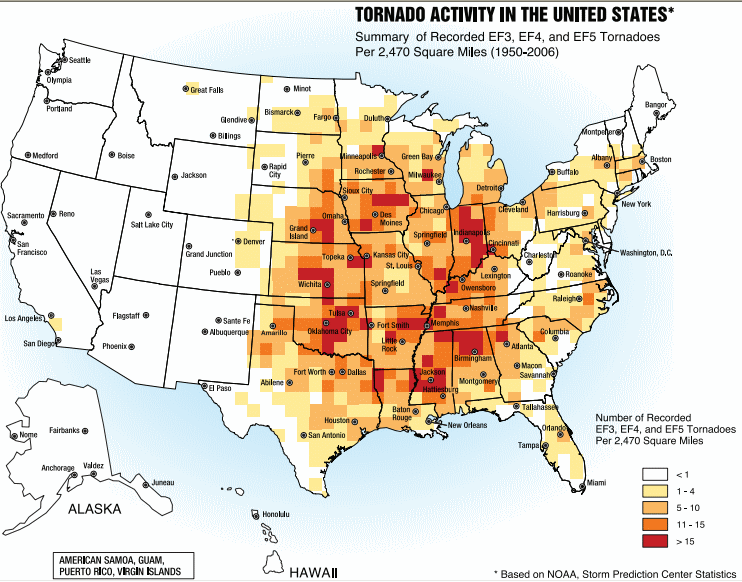 Tornadoes:
Tornadoes: Tornadoes are one of the world's deadliest hazard affecting many people around the world in various places. Tornaodoes starts within thunderstorms known as a 'supercell'. When the warm moist air is lighter than the cold dry making a strong updraft. As the warm moist air rises, it meets with varying wind, and they will act on the upward rising air, spinning it like a top. The storm will then show a visible rotation, often forming a 'wall cloud'. Inside the storm, these spinning clouds will begin to form a tornado. From this point on, 35% of this storm will continue to become tornado, but about 95% will produce a very severe storm.
Tornadoes can cause tremendous harm to it's surroundings. The force of the tornado winds pushing  the wall inward will result with roofs of buildings being lifted up, and remaining walls crushed. Flying debris are the most dangerous of all what tornadoes can bring. Tornado itself won't cause much injuries towards human beings, but what the tornadoes pick up can cause deadly injuries or even deaths. Sticks, glass, rods, roofing materials, furnitures, and other basic items become deadly items as it can and will hurt within the areas of the tornado.
the wall inward will result with roofs of buildings being lifted up, and remaining walls crushed. Flying debris are the most dangerous of all what tornadoes can bring. Tornado itself won't cause much injuries towards human beings, but what the tornadoes pick up can cause deadly injuries or even deaths. Sticks, glass, rods, roofing materials, furnitures, and other basic items become deadly items as it can and will hurt within the areas of the tornado.
Tornadoes hit in all sorts of places such as places in the United States, southern Canada, south-central and eastern Asia, east-central South America, Southern Africa, northwestern and central Europe, Italy, western and southeastern Australia, and New Zealand. The United States have the most tornadoes out of any of these countries.
Tornadoes affect different countries differently as to LEDCs and MEDCs. With the LEDCs, tornadoes might be the same strength as the ones that appeared in MEDCs, but it's damage is a lot more. LEDCs will take longer to recover its' losts as it needs aid to rebuild it's buildings, and help the ones who have been injured. MEDCs on the other hand has the money to improve it's buildings' stability, and recover what it lost. They have plenty of money to cure the injured ones. People live in these places of where the tornadoes often hit is quite simple. They choose to live there, because they like the land, the scenery, their jobs are located there. They've been living there their whole lives. They also live there, because it's the only place they can afford to live in, and cannot afford to move.
Specific Hazard:
One of the largest tornado outbreak is known as the 'Super Outbreak'. From April 3 to April 4, 1974, there were 148 tornadoes confirmed in 13 US states, and one Canadian province: Ontario, Illinois, Indiana, Michigan, Ohio, Kentucky, Tennesse, Alabama, Mississippi, Georgia, North Carolina, Virginia, West Virginia and New York. It damaged around 900 square miles (1,440 square kilometers) along a total combined path length of 2,600 miles (4,160 km). A powerful spring-time low pressure system developed across the United States Plains on April the 1st. While moving into the Mississippi and Ohio Valley areas, a surge of very moist air intensified the storm further while there were sharp temperature contrasts between both sides of the system. Over the next 2 days, 148 tornadoes were confirmed to hit over most of the central and eastern North America along with one province in Canada.

In conclusion, tornadoes are one of mankind's deadliest natural hazard, but there are a lot of ways we can prevent from it. Now, we can detect tornadoes with storm spotting/visual evidence, and radar. In storm spotting, there are professionally trained watchers who can detect a tornado in the making such as seeing a supercell in the making. With the developed radar, it can spot a tornado from evidence in rotating storm. When a tornado warning is issued, going to a basement of a strong building increases chances of survival. In tornado-prone areas, many buildings have storm cellars on the property. These underground refuges have saved thousands of lives. People should also park their cars far away from roads as it can block traffic.
Work Cited:
http://www.windows.ucar.edu/tour/link=/earth/Atmosphere/tornado/formation.html
http://en.wikipedia.org/wiki/Super_Outbreak
http://www.redcross.org/news/ds/tornadoes/images/hoisington24_rubble2.jpg
http://en.wikipedia.org/wiki/Tornado#Definitions
http://en.wikipedia.org/wiki/Tornado#Safety
http://en.wikipedia.org/wiki/Tornado#Life_Cycles


No comments:
Post a Comment